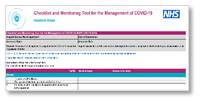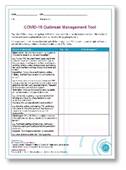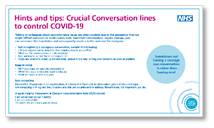Supporting excellence in infection prevention and control behaviours implementation toolkit
Contents
- Implementation Toolkit
- Introduction
- Research summary
- Every action counts
- Resources
- Operational resources
- Innovation ideas for local implementation
Publication approval reference: C1116
Supporting excellence in infection prevention and control behaviours
Implementation Toolkit
Introduction
Background
Throughout the COVID-19 pandemic, efforts have been taken at local, regional and national level to maintain the highest level of IPC excellence, reducing the risk of nosocomial (healthcare acquired) infections and making NHS settings safer.
To support NHS organisations in the recovery and restoration the Infection Prevention and Control (IPC), Communications, and Behavioural Change Unit (BCU) teams partnered to deliver a research project aimed at unpicking the complex drivers of behaviours that influence compliance with COVID-19 IPC measures.
Insight was gathered from frontline staff, patients, professional bodies, and clinical, communication and IPC experts to understand these drivers, and a suite of co-designed products developed to address the key themes.
Purpose
This implementation toolkit is designed as a one stop shop to provide information, resources, and ideas to local NHS organisations to address the barriers for behavioural compliance with IPC measures.
This includes resources and tools targeting compliance and awareness, leadership, morale and wellbeing, training, and operational interventions.
Innovation ideas to support local intervention have also been collated from the research and packaged at the end of this document for local consideration.
Contacts
For any questions on the content in this toolkit, please contact:
- Infection prevention and control (IPC)
NHS England and Improvement IPC team
nhseandnhsi.ipc-cell@nhs.net - Communications:
Ashley Langton
Head of Communications
ashley.langton1@nhs.net - COVID-19 Behavioural Change Unit
NHS England and Improvement
england.covid-sustainablehealth@nhs.net
Research summary
Context
Behaviour is driven by a number of factors that all influence why and how people act. This includes internal factors such as subconscious motivations, personality, and perception of risk, as well as external factors such as culture, environment, and wellbeing (physical, mental and emotional).
There is a need to focus on what can be done to support better behaviour with everyone being compliant – staff, patients and visitors.
Key insights
- Strong, compassionate leadership and role modelling is absolutely critical – local implementation will be vital to the success of any interventions.
- As more people are vaccinated, personal risk will be lowered. We need to enhance the mindset of the workforce from protecting SELF while also protecting OTHERS and create a culture of kindness where compliance is associated with being kind and caring to all.
- Staff need support to challenge colleagues and patients/visitors on IPC compliance, particularly when speaking to senior staff and medics. Providing staff with the tools and support to both speak up and “listen up” will help address this.
- “Hotspots” are areas where infrastructure issues (mainly space) aren’t easily overcome but can be improved with some quick fixes, improved monitoring, and situational comms.
- Training to further enhance awareness and understanding of IPC measures and their purpose across all healthcare professions will support better compliance.
- Clear messaging for patients and visitors is essential, outlining not just what we want them to do, but how to do it e.g. wearing a mask over nose and mouth. Direct messaging was felt to be more effective than softer messaging for this group.
- A zero-risk approach to sickness will relieve pressure on staff to come in with minor symptoms
Every action counts
The ‘Every action counts’ suite of resources have been developed to support NHS organisations to communicate with and apply compliance interventions to staff, patient, and visitor groups.
The research stressed the importance of communicating with these groups regularly through a variety of different formats and channels to reinforce expected behaviours.
The resources have been co-designed with partners and are insight driven to frame the conversation. They can be adapted to your local context and setting as needed. The resources have been co-designed with partners and are insight driven to frame the conversation. They can be adapted to your local context and setting as needed. As each setting and geographical region will have a different context, the resources should be adapted as required to be effective in that setting and support your local needs.
Situational reminders in key areas throughout the healthcare setting should be considered to remind people ‘in the moment’. This includes thinking about location (for example, staff break and changing rooms) and channel (for example, using TV screensavers throughout the hospital).
Graphic device and colours
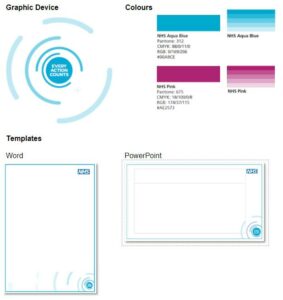
Key messages
- Every action counts – each action you take has a big impact.
- We all have a responsibility to reduce the spread of coronavirus.
- People with COVID-19 can have very mild or no symptoms at all. This means they can transmit the virus to others without being aware of it.
- To reduce the risk for staff, patients, and visitors, we all need to do things differently to what we would normally do for a little while.
- You should always follow the rules, even when only with colleagues, family, or friends.
- When you follow these measures, you’re playing your part. Thank you.
- You can still spread the virus to others, even if you have been vaccinated.
Additional patient and visitor messages
- We want to keep you, your family, other patients and our staff safe from coronavirus.
- Because we care, we may ask you to do things differently while you are here:
- Always wear a mask or face covering over your nose and mouth while inside
- Make space for others – 2 metres
- Don’t visit other parts of the hospital unless you are asked to by a member of staff
- Wash or sanitise hands regularly
- Take a test if asked to
- It’s ok to remind doctors, nurses and fellow patients that we need to make space for each other and to cover our mouths and noses. Reminders can help us all to look out for each other.
Additional staff messages
- Observing IPC measures helps keep your colleagues, patients, family and friends safe from coronavirus.
- There is no such thing as a ‘work bubble’. The virus can still spread between colleagues, so it is important to wear a mask and maintain physical distancing when on breaks and outside of work.
- If you see something, say something – it is ok to gently remind colleagues, patients, and visitors to make space, fix or change their PPE, or observe other measures.
- We’re all in this together – it has been a challenging year and taking care of each other is important. If you need help, ask for it.
Resources
Staff assets
The insight showed a need to reframe IPC compliance away from directive measures towards engaging the hearts and minds of staff and emphasising the impact our actions have on others.
Staff engagement assets can be downloaded from the Campaign Resource Centre.
- Because I care video

The ‘Because I care’ video was developed by the South West regional team and has been further enhanced through the research to form the basis of the Every Action Counts staff engagement resources.
- Because I care – posters
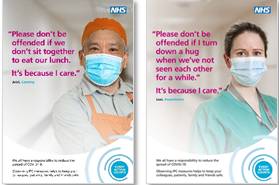
Poster versions of the ‘Because I care’ video help to reinforce these messages for staff and should be placed in staff-areas such as break rooms, changing rooms, offices, and canteens to remind staff of the expected behaviours. Artwork files are available on the CRC and staff photos can be swapped for other settings if relevant e.g. primary, community, or social care workers.
- Digital cards
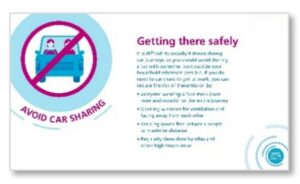
Digital cards with key messages for staff help organisations to share important information about how staff can be safe at work, covering care sharing, PPE, safe breaks, and asymptomatic testing. These should be used on staff channels such as staff apps, intranets, staff newsletters, and computer screensavers.
Patient assets
The insight showed a strong call for interventions for patients and visitors to be simple and practical with strong, clear messaging on what measures are in place.
The value of face-to-face interactions to ensure compliance was clear, supported by information prior to arrival and situational reminders throughout the healthcare setting. This aligns with the Good communication with patients minimum standards.
Resources
The following assets have been co-designed with patients and are based on insight from patient representatives and patient groups to support compliance with IPC measures. They can be downloaded from the Campaign Resource Centre.
Information resources for patients:
- Template pre-hospital / admission information leaflet on IPC measures
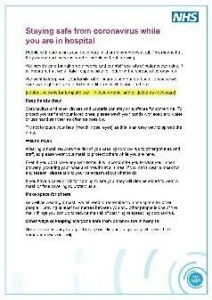
Information on the COVID-19 IPC measures should be provided as part of best-practice proactive patient communication e.g. with confirmation letters and other pre-appointment information. This content outlines the key measures that may be in place in your service in plain English but should be amended, added to, or deleted as needed.
- Easy read patient information leaflet on IPC measures
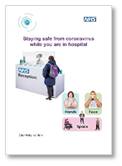
An easy read version of the patient information leaflet has been developed to support people with learning difficulties or disabilities.
- Template patient charter
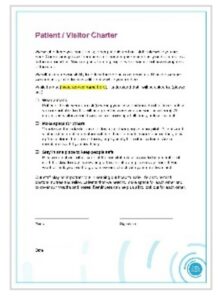
Some trusts have had success with a patient charter approach that recognises we all have a responsibility to reduce the spread of coronavirus. This should not be presented as a formal contract, but rather as mutual recognition of the moral responsibility of the signee (the signature piece section can also be removed and used without).
Situational reminder cards:
- Poster – IPC measures
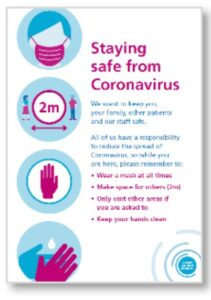
The IPC measures poster reminds people of all four key actions to take for IPC (hands, face, space, and not moving around the hospital unnecessarily). This can be used around the estate and on social media.
- Digital cards – key behaviours
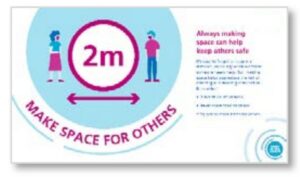
The key behaviour digital cards have been developed to focus on a particular action (e.g. wearing masks properly) and can be displayed on TV screens and other digital channels throughout the facility or be used on social media.
- A4 posters – key behaviours
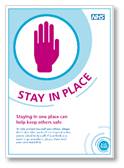
The key behaviour posters have been developed to focus on a particular action (e.g. not wandering around the facility) and can be displayed throughout the building (these should be laminated or in specific holders to reduce spread risk and enable appropriate cleaning). Consider placing these in relevant areas where you want the behaviour to happen i.e. Keep hands clean poster next to a hand sanitiser dispenser, as well as generally around the estate.
- Placemat – IPC measures
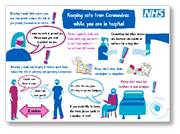
The IPC measures placemat is an illustrated piece that aims to explain COVID-19 measures in an engaging way. It is intended to be used when receiving meals to engage patients when they have time to look at the content a little more. The individual sections can also be used as social media and other content.
Operational resources
Leadership
Leadership emerged as a strong theme. There is lots of anecdotal evidence that trusts with strong, visible leadership on IPC and exemplary role modelling from ward managers, matrons and senior medics have better compliance with measures.
Key principles for leadership include:
- Role modelling is essential at all levels
- Lead by example, practice good IPC
- Be visible – walk the rounds
- Let staff know that it is ok to remind you as well
- No risk approach to illness – be supportive and trusting of illness so that staff do not feel compelled to work when sick
- Promote the IPC guidance – constantly remind in all interactions with staff
- Collective leadership is important to provide greater consistency of IPC processes and guidance between wards, departments and trusts. This will help to foster trust and compliance among staff
- Show support – ask staff how they are feeling and remember to thank them for their work
- Strong leadership can come from any level and doesn’t have to be top down – recognise who those people are in your team and empower them
Resources
Checklists
Checklists have been developed to support NHS organisations to implement preventative measures and reinforce good IPC practice.
This checklist identifies preventative actions that can be taken to reduce risk across different settings – inpatient, outpatient, and emergency departments.
The outbreak prevention tool (OVAT) is a quick and handy ‘walkaround’ guide to support leaders.
The OVATwas developed by Dr Evonne Curran and Maurice Maddao.
IPC champions
Role champion profiles have been developed to support the whole team approach to IPC excellence:
- IPC champion role profiles
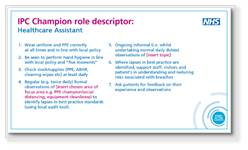
This tool outlines the principles underpinning IPC role champion activities and gives examples how this role could be implemented across a range of professional and volunteer groups during their everyday work. You can also consider how to adapt these role cards for additional roles or settings to support your local organisation.
Creating a culture to speak up on IPC compliance
Many staff find it difficult to challenge non-compliance, even with their close peers, and can be intimidated by hierarchy or those they perceive to have more influence than them.
Supporting a culture where everyone is empowered to speak up and receptive to feedback is really important. A reminding culture.
We need to empower all staff with the confidence and language to speak up when someone is letting their guard down.
Key principles for creating a culture to speak up include:
- Sharing messages about it being ‘ok’ and expected to speak up at every briefing, every handover, every interaction
- Senior leaders reinforcing these messages in all communications and interactions
- Encourage staff at all levels to take feedback in good faith, assume positive intent and not react badly when reminded by other people
Resources
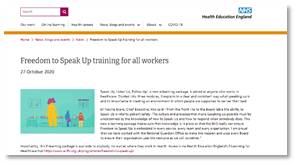
Health Education England has developed a suite of training to encourage staff at all levels to drive and participate in a speak up culture. This training is for everyone wherever they work in healthcare and explains in a clear and consistent way what speaking up is and its importance in creating an environment in which people are supported to deliver their best.
The ‘Speak Up’ training can be accessed at:
https://www.e-lfh.org.uk/programmes/freedom-to-speak-up/
For IPC, creating an open and transparent culture that empowers staff to speak up to others is essential to support compliance with IPC measures.
Quick reference cards have been developed to support staff to speak up and remind colleagues and patients/visitors when they are not following IPC measures, including tips on preparing for the conversation and helpful ways in.
Wellbeing and morale
Wellbeing and morale are important underlying factors when considering staff behaviour.
Staff are more likely to comply with IPC measures when they feel supported by their leaders and organisation, and that their concerns are listened to and quickly acted on.
Key principles for maintaining staff wellbeing and morale include:
- Saying thank you and well done goes a long way
- Communication and messages should be two way and should check in with staff to see how they are feeling and if they need more support
- Demonstrate empathy and take time to listen – a culture where it is ok not to feel ok
- Speed is key – when concerns are raised, listen and respond as quickly as possible to ensure staff feel heard and that their concerns are taken seriously
Resources
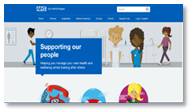
Supporting our NHS people is a key priority for NHS England and NHS Improvement, and a full range of support and educational resources can be accessed at https://www.england.nhs.uk/supporting-our-nhs-people.
Local intervention ideas to support wellbeing and morale can be found at the end of this toolkit.
Training
The research indicated further education is needed to support staff awareness and understanding of IPC measures and how control measures work together to reduce risk.
Resources
A suite of training animations is being co-designed with stakeholder partners to target the core areas of IPC understanding related to COVID-19.
The first of these videos addresses the Hierarchy of Controls:
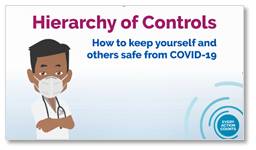
- How transmission of a virus occurs
- Factors that contribute to spread
- Recognising risks to staff and patients.
Innovation ideas for local implementation
In addition to the resources developed nationally, the research process highlighted a great number of innovative approaches to IPC compliance already in use across the NHS, as well as gathering a wealth of ideas from frontline staff, patients, stakeholders and behavioural experts.
These intervention ideas can be considered for implementation at a local level according to need and context.
Wellbeing and morale
- Staff buddy system
Staff buddy systems are a great way to ensure that staff have someone to check in with and/or ask for help from when they need it. They can also help to remind each other to follow IPC measures in the moment. These don’t need to be two people only – small buddy groups can be used to cover different working patterns. - Create a virtual hug
To replace real hugs while social distancing measures are in place, consider implementing a team or organisation ‘virtual hug’ to show support for one another during challenging or stressful times. One example of this is the distanced ‘fist bump’ in the Real Hero 6 movie. - Message support boards
A message board for staff to leave each other comments or messages of support can provide a nice channel for teams to communicate across shifts and working patterns. Consider making this virtual – a good example of this is the well-known @allontheboard twitter channel. - Wobble rooms
Consider dedicating a particular room or space as a staff ‘wobble room’ – a safe space to go and take a minute when staff become overwhelmed. This space could include messages and resources to help people in the moment, for example, a poster outlining breathing techniques. - Create team WhatsApp groups
Team WhatsApp groups are a great way to create an informal channel for staff to communicate and check-in with each other and provide support if needed. - Access to the local psychology services
Some teams told us that giving staff access to trust psychology services in addition to employee assistance programmes (EAP) helped their staff to process the pressure and stress they were feeling to support wellbeing. - Daily Dose toolkits
Pulling together a suite of images/videos/animation of feel-good messages to share with staff (through WhatsApp, intranet, bulletins etc) can help to improve morale and wellbeing. - Mindfulness moments
Taking a moment to check in at the beginning of every shift can help to set the mood and morale of staff. A mindful moment can include a few minutes at handover for each shift where positive messages and support is provided to staff. - ‘Teams’ breaks
Creating an online ‘room’ that is always open can help people to chat in a socially distanced way and feel more supported during their breaks.
Creating a speak up culture
- Key message stickers
Stickers for staff and patients to wear can remind others of the correct behaviours and help support a culture of speaking up. Example messages could include things like ‘The best way to support me is to wear a mask properly’ and ‘If I keep my distance, it is because I care’. - Elect team speak up champions
Team champions can help to create a culture of positive reminding and can also act as a support for staff who feel uncomfortable speaking up with others. This could be a rotating role to help embed the speak up culture across all levels and professions. - Safety words
Safety words are already used in some healthcare environments (for example, surgical theatres) for all staff to stop and check safety measures. A similar concept could be applied to IPC measures, where a nominated word (unrelated to environment i.e. pineapple) can be used to remind everyone to stop momentarily and check their PPE and environment for compliance. - Create an anonymous escalation process
Even with support, some people may not ever feel confident to speak up. Creating an anonymous escalation process allows their voices to be heard and ensures that positive intervention can be achieved.
Leadership
- Daily messages to staff
A personal message can be very powerful. A daily message from leaders (senior or area lead) can provide connection and emphasis that staff are supported. This can be delivered in different formats – through a quick written message, a meme, or an informal video. - Rotating daily IPC champion
IPC is everyone’s business, but it can be easy to call the IPC team to deal with an issue rather than ruffle feathers. Creating a rotating daily IPC champion rota for all multidisciplinary team (MDT) staff helps to embed IPC as a role we all have to play across all levels and professions, ensures local responsibility is taken for identifying and managing IPC compliance issues, and supports organisational IPC teams. - Volunteer support
Volunteers are a great resource for organisations and already play an important role in the NHS. Consider creating volunteer roles to support compliance and behaviour – these volunteers could act as safety ambassadors reminding people of behaviours in public spaces such as canteens and corridors and/or provide arrival briefings on local measures for patients and visitors. - Safety huddles
Dedicated safety huddles focus on IPC and safety measures and help to embed the importance of these topics in the organisational culture, rather than tacking them on to the end of other huddles in a hurry. - Establishing a ‘faceless’ sickness line for staff
It can be difficult for staff who are feeling unwell to call in sick when they are speaking to their team lead or line manager and may feel like they are letting the team down / adding pressure in already challenging times. It is important to embed a no risk approach to staff illness to reduce the risk of staff spreading illness when they really should not be at work. Absence phonelines for reporting sickness to remove difficulty of reporting to managers have proved to be effective. - Virtual meetings and handover
Where possible, switching face to face meetings, handovers and debriefs to virtual meetings means that staff can remain distanced but provide group feedback. This could be delivered through a range of channels including Microsoft Teams, WhatsApp, or a local platform.
Patients and visitors
- Front door ‘greeters’
Non-verbal cues such as smiling are missing in a world full of masks and PPE. Some hospitals already have security in place at front doors to ensure compliance with mask wearing but consider the use of volunteers or dedicated staff at the front door to further help explain the measures in place across the service, as well as providing direction and support within the building. - Community language videos
If your demographic includes a large community of other language speakers, consider filming additional videos explaining the measures in those languages. If you can find a local clinician who speaks the language and is representative of the community this will help it to be well received by the community. - Pre-hospital text message
Many hospitals provide a pre-hospital visit text message to patients coming in for planned and elective care. Consider including a link to pre-hospital resources (including videos, patient information leaflets etc) in the text message to make the information as accessible as possible. - Staff pictures
Staff in full PPE can seem very remote and ‘faceless’ to patients. Consider if there is a way to make photographic badges or laminated pictures of staff with their face showing to reduce the barriers between staff and patients – this can help requests from staff land better. - Post-discharge feedback
Post-discharge surveys are a great way to get feedback from patients on how they experienced care. If your services run a post-discharge survey, consider including a question about the information they received regarding IPC measures: was it enough, and did they understand it to support ongoing evaluation of your local measures.
General safety
- Temperature checks at the front door
Most people are now used to getting their temperature taken when visiting restaurants and other settings. Implementing temperature checks at non-emergency entrances helps to identify those who may not know they are ill so that appropriate safety measures can be taken. Consider utilising your volunteer workforce to help keep this process smooth (NB: Appropriate masks etc would need to be provided to temperature takers. Local processes must into account that people attending hospital may have other illness that creates temperature spikes). - WIFI login page
Most patients and many staff will utilise free WIFI offerings, creating another opportunity to share messaging. Consider adding videos, infographics, or visual key messages on the WIFI login page with a link to more information about the measures in place across the service.
Estate
- Contactless ‘office’
A contactless building can help to reduce the need to press buttons or touch handles by implementing swipe cards or phone app access wherever possible. - Staff only bathrooms
Consider designating some bathroom facilities as ‘staff only’ to reduce traffic in the same facilities between staff and the public. - Create more space for breaks
Limited space means that it can be challenging for staff to maintain physical distancing while on breaks. Consider alternatives/additions such as heated marquees and tents to create more space for staff while on breaks. - Visual cues
Many organisations will already be using visual cues such as coloured floor tape and signs to remind people to maintain physical distance or to remind them that they are leaving an area. Consider if these visual cues extend to your staff only areas such as break rooms and changing rooms and implement there as well if not. - Waiting room layout
Some waiting rooms are not conducive to IPC compliance. Consider how chairs are spaced and restrict use of other chairs and surfaces between these spaces. Diagnostics waiting rooms were raised as a particular area for consideration. - Removable signage
Consider developing signage that can be moved and flexed to the needs of the facility. One example of this could be a pull-up banner i.e. You are now entering a red zone. Rules in this zone include…’
Cleaning
- ‘I’m clean’ notice
An ‘I’m clean’ note or sticky tab can provide a quick and easy way of knowing that a workspace or shared equipment has been cleaned and sanitised. The tabs should include a date and time to support regular cleaning. - Changing rooms cleaning rota
Creating a changing room cleaning rota or making sure that there are dedicated people assigned to keep changing rooms neat and tidy helps to ensure there is no cross contamination in shared spaces.
Staff / workforce
- Family portraits
Pictures of loved ones can help to remind staff why following IPC measures is important. The pictures can be laminated and put on walls in staff only areas as a reminder to stay safe at work so they don’t take COVID home with them. - Flexible working from home policies
Not all staff can work from home, but for those who can it is much safer and reduces the number of people (and thus risk) in the healthcare setting. - Own pen and mug policy
Creating an own pen and mug policy reduces the risk of cross-contamination among staff. - Staggered break times
Staggered break times can help to reduce the number of people in a space (break or changing room for example) and reduce the risk of large numbers of people together at once. Staggered break times should be considered locally as this is not always a popular intervention with frontline staff who feel they need the ‘downtime’ with the colleagues during breaks. - Staff processes
Ensuring staff processes are in place and clearly communicated and understood means that there is less risk of mistakes, for example red bags for scrubs.

